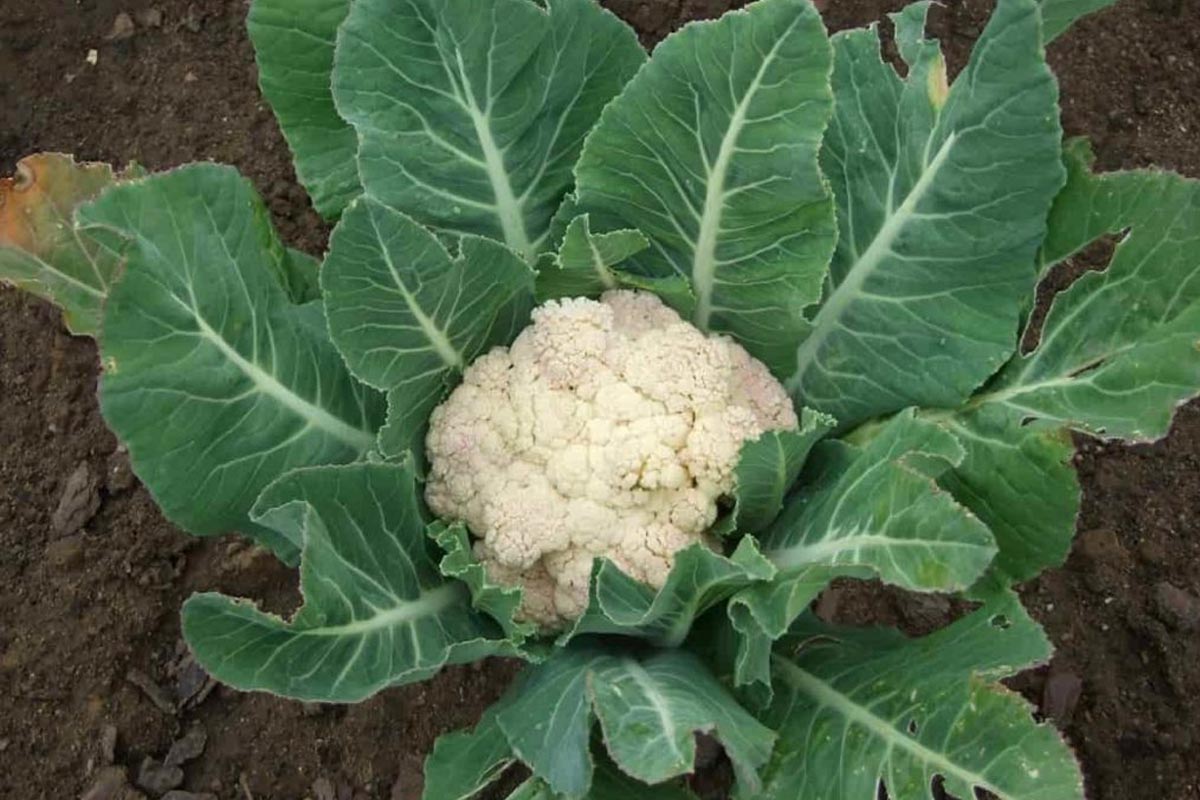Plants
Cauliflower
Introduction / परिचय
Cauliflower, a versatile and nutritious cruciferous vegetable, boasts a distinctive appearance and a bounty of culinary possibilities. Belonging to the Brassicaceae family, this cool-season crop thrives in well-drained, fertile soil and cool temperatures. With its tight clusters of white curds, cauliflower is a culinary canvas for creative dishes, adapting to various cooking methods and flavours. Renowned for its health benefits, cauliflower is a rich source of vitamins and antioxidants. As a cool-weather companion, these plants require careful cultivation, making them a rewarding challenge for gardeners. Join us as we delve into the fascinating world of cauliflower, exploring its cultivation, care, and culinary wonders.
Also Read This :How to Grow Sunflower from Seeds At Home
| English Name: | Cauliflower |
| Hindi Name: | फूलगोभी (Phool Gobhi) |
| Scientific Name: | Brassica oleracea var. botrytis |
| Family: | Brassicaceae |
| Kingdom: | Plantae |
| Light : | 6-8 hours of direct sunlight |
| Height: | 1-2 feet |
| Flower Color : | white or off-white |
| Leaves Color : | Light Green to Deep Green |
| Eason Features : |
Also Read This :Greening Your Home: The Benefits of Indoor Plants
When to Plant Cauliflower
The timing for planting cauliflower depends on the climate and the specific variety you're growing. Cauliflower is a cool-season vegetable whose growth is influenced by temperature and day length. Here are the general guidelines:
Spring Planting
In regions with mild winters, you can start cauliflower indoors 6-8 weeks before spring's last expected frost date. Transplant seedlings outdoors when they are 4-6 weeks old and the soil temperature has reached around 50°F (10°C).
Fall Planting
You can also plant cauliflower in late summer for a fall harvest in cooler climates. Start seeds indoors early to mid-summer and transplant seedlings outdoors 10-12 weeks before the first expected fall frost. Cauliflower thrives in cooler temperatures, so the goal is to have it mature during the cooler fall weather.
Winter Planting
In regions with mild winters, you can plant cauliflower in late fall or winter for a winter harvest. Planting times can vary, so it's essential to consider your specific climate conditions.
Also Read This :Easy way to grow Strawberry at Home
Flowering time of Cauliflower
Cauliflower (Brassica oleracea var. botrytis) is a cool-season vegetable primarily grown for its edible white flower head. The flowering time of cauliflower depends on the variety and growing conditions. Here are some general guidelines:
Time to Maturity
Cauliflower typically takes about 2 to 3 months from transplanting to reach maturity. The exact time can vary based on the specific variety you're growing.
Harvest Time
The actual cauliflower flowering leads to the formation of the edible head. Harvest time is when the head is compact and firm, and the curds are still closed. Harvesting too late may make the head lose "rice."
You must check the specific variety you are growing for more accurate information about its flowering and maturity times. Additionally, local climate conditions can influence the timing of cauliflower flowering and maturity, so observing the plant's growth and monitoring environmental conditions is beneficial for a successful harvest.
Also Read This :What is Coco peat ? & How to Make Coco peat at Home
Varieties / किस्मे
Cauliflower comes in various varieties with unique characteristics, including colour, size, and flavour. Here are some popular cauliflower varieties:White Cauliflower
Snowball:A classic and early-maturing variety with compact heads.
Amazing:Known for its large, dense heads and good flavour.
Early Snowball Y:A hybrid variety with uniform, early heads.
Purple Cauliflower
Graffiti:This variety has vibrant purple heads and a nutty taste.
The purple of Sicily:Known for its striking purple colour and tender texture.
Orange Cauliflower
Cheddar:An orange cauliflower variety with a mild, cheddar cheese-like flavour.
Orange Burst:Another orange variety with a sweet taste.
Green Cauliflower
Verde di Macerata:A unique variety with green heads and a nutty flavour.Romanesco Cauliflower
Romanesco:Distinctive for its striking fractal-like pattern and mild, nutty taste.
Broccoflower
Green Macerata:A hybrid between broccoli and cauliflower, featuring a lime-green colour and a milder flavour.
Baby Cauliflower
Fioretto:Known as "flowering cauliflower," it produces small, tender florets with a sweet taste.
Mini Cauliflower
Mini White:Compact, small heads that are perfect for individual servings.
Mini Purple:A mini variety with vibrant purple heads.
All-Year-Round Cauliflower
All-Year-Round:A variety bred for consistent production throughout the growing season.
Self-Blanching Cauliflower
Self-Blanche:Known for its leaves that naturally cover and protect the curd, reducing the need for manual blanching.
When choosing cauliflower varieties, consider your culinary preferences, the desired colour palette for your garden, and the specific growing conditions in your region. Each variety brings its appeal to the table, providing versatility in both the garden and the kitchen.
Also Read This :12 Delicious and Nutritious Herbal Teas to Boost Your Health
Classification of Plants/ पौधों का वर्गीकरण
Cauliflower is known for its cruciferous vegetables. Classified under the species Brassica oleracea, cauliflowers are further categorized into several cultivar groups based on their unique characteristics. These groups include the traditional white-headed varieties, colourful cultivars such as orange, green, and purple, and Romanesco types known for their mesmerizing fractal patterns. Additionally, cauliflowers can be grouped by maturity dates, offering early, mid-season, and late-season varieties. This classification allows gardeners to select cauliflower plants suited to their growing conditions, ensuring a diverse and flavorful harvest throughout the growing season.
Also Read This :10 Summer Solutions: How to Safeguard Your Balcony Garden from Heat Stress and More
History / इतिहास
Cauliflower's history traces back to the Mediterranean region, where wild predecessors were cultivated over 2,000 years ago. Ancient Romans appreciated its mild taste and versatility. Initially, cauliflower had a variant appearance, more resembling broccoli. The familiar white curd emerged in the 18th century through centuries of cultivation and selective breeding. Initially a delicacy, its popularity surged in the 19th century, spreading across Europe and beyond. Today, cauliflower is a global culinary staple, cherished for its nutritional value and adaptability in diverse cuisines. Its journey from wild predecessors to a kitchen staple reflects a rich botanical and culinary history.
Also Read This :Discover the Secrets to Growing Beautiful Cardamom Plants!
Uses and Benefits / उपयोग एवं फायदे
Cauliflower, a cruciferous vegetable, offers a multitude of uses and health benefits. Rich in vitamins C and K, it supports immune function and bone health. Its high fibre content aids digestion and promotes a feeling of fullness, helping in weight management. Cauliflower's versatile nature makes it a low-carb substitute for rice or mashed potatoes, catering to various dietary needs. Additionally, it contains antioxidants, known for their potential cancer-fighting properties. This nutrient-dense vegetable supports heart health, regulates blood pressure, and contributes to overall well-being, making it a valuable addition to a balanced and nutritious diet.
Also Read This :Rubber Plants: A Beginner’s Guide to Growing and Maintaining Them
How to Grow Plant / कैसे उगाएं
Growing cauliflower can be a rewarding experience, but it requires attention to detail and the right conditions. Here's a step-by-step guide on how to grow cauliflower:
Choose the Right Variety
Select a cauliflower variety that suits your climate and preferences. Varieties like 'Snowball' and 'Amazing' are popular choices for home gardens.
Start Indoors or Direct Sow
Indoors: Start seeds indoors 6-8 weeks before the last expected frost. Transplant seedlings outdoors when they are 4-6 weeks old.
Direct Sow:In regions with mild winters, cauliflower can be directly sown in the garden in late summer for a winter harvest.
Select a Sunny Location
Choose a site with total sun exposure. Cauliflower requires at least 6 hours of sunlight per day.
Prepare the Soil
Ensure well-draining soil rich in organic matter.Maintain a slightly acidic to neutral soil pH (6.0-7.0).
Planting
Set transplants 18-24 inches apart in rows 2-3 feet apart.Plant seedlings at the same depth as they were in the pots.
Watering
Keep the soil consistently moist, especially during dry spells.Avoid overhead watering to prevent disease.
Fertilization
Provide a balanced fertilizer at planting time.Side-dress with a nitrogen-rich fertilizer when the plants are about 3-4 weeks old.
Mulching
Apply a layer of mulch to help retain soil moisture and control weeds.
Pest and Disease Management
- Monitor for common pests like cabbage worms and aphids.
- Use row covers or natural predators for pest control.
- Practice crop rotation to reduce disease risk.
Blanching
As the cauliflower heads begin to form, consider blanching them by tying the outer leaves over the head to protect them from sunlight. Cauliflower maintains the white colour and improves the flavour.
Harvesting
Harvest when the heads are firm, compact, and reach the desired size.Cut the head from the stem using a sharp knife.
Post-Harvest
After harvesting the main head, some varieties produce side shoots. Continue to gather these for an extended harvest period.
Following these guidelines, you can cultivate healthy cauliflower plants and enjoy a bountiful harvest of this nutritious and versatile vegetable.
Also Read This :Revitalize Your Mind and Body with the Power of Brahmi
How to Take Care/ देखभाल कैसे करे
Cauliflower, a cool-season vegetable, thrives with proper care. Plant in well-draining soil enriched with compost. Choose a sunny location for optimal growth. Keep the soil consistently moist, providing about 1 to 1.5 inches of water weekly. Mulch around the plants to retain moisture and suppress weeds. Fertilize with a balanced fertilizer during the growing season. Blanch by tying leaves over the developing curd to protect cauliflower heads from discolouration. Watch for pests like cabbage worms and aphids, applying organic insecticides if necessary. Harvest cauliflower heads when they reach the desired size, cutting them cleanly to encourage side shoot production.
Also Read This :3 Method to Grow Mint (Pudina) at Home
Interesting Facts / रोचक तथ्य
Also Read This :How To Grow Gazania Flower at Home




